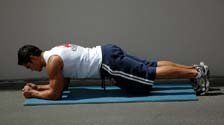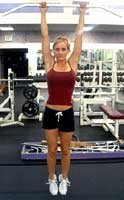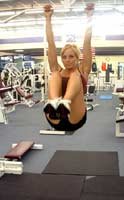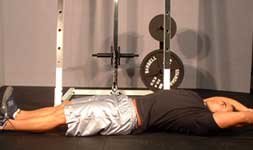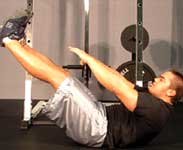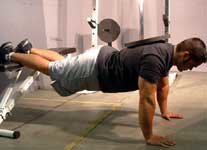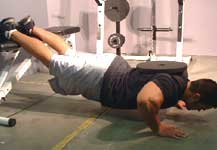
TOPIC: What Training Program Would Benefit A Gymnast The Most?

The Question:
Aside from the normal grueling gymnastics training, weight training is also important. This additional training is especially important for the older gymnasts at the college level and beyond whether to strengthen the core or rehabilitate.
What training program would benefit a gymnast the most (i.e. Plyometrics, HIT, Core)?
What is a good routine from one of these programs? Be specific.
Would this workout benefit anyone other than gymnasts?
What are some of the most important physical characteristics of a gymnast (strength, flexibility, etc.)?
Show off your knowledge to the world!
The Winners:
- Blink41 View Profile
Prizes:
- 1st place - 75 in store credit.
- 2nd place - 50 in store credit.

1st Place - Blink41
View This Author's BodySpace Here.


What Training Program Would Benefit A Gymnast The Most?
I believe core training is of the utmost importance in gymnastics. Contrary to popular belief, training the core is much more than simply training the abs. The muscles of the core consist of all the muscles that help stabilize the spine, pelvis and shoulder girdle.
If you lift weights regularly, then you should know a good solid core helps transfer the energy from the center of your body to your outer limbs efficiently.
If you are a gymnast, the importance of a strong core is even more essential. The muscles of the core include the Rectus Abdominis (AKA The 6-pack), Transverse Abdominis, Inner and Outer Obliques. Throughout this article, you will discover a variety of exercises to hit each muscle group of the core as well as the many benefits of core training.

What Is A Good Routine From One Of These Programs?
Unlike bodybuilders, gymnasts should shy away from weightlifting as it is counterproductive to your gymnastic goals (Size to strength ratio will decrease).
Instead, gymnasts should perform a variety of bodyweight exercises with higher repetitions to build muscular endurance. The rep range should be between 15 to 30 repetitions depending on the muscle group being work. Hand and wrist strength is also important and thus needs to be trained.
Here is a good routine a gymnast should use:

The Plank:
- The plank is a classic core exercise.
To perform this exercise, get into a pushup position but instead of using your hands, your entire forearm should be on the mat. Keep your back straight and feet together, hence the name plank, hold the position for as long as you can.
- As your core becomes stronger, this exercise will take up a lot of time. To increase the difficulty, simply use only one foot or one forearm, or both. Aim for 30-60 seconds, 2 sets total.
The plank can also be done with your feet/foot on an exercise ball. This version of the plank requires the use of your hands and not forearms, and is much harder than the traditional plank. You will also develop great balance, which is just as important as strength in gymnastics.

Hanging Leg Raise:
- In order to perform this exercise, hang on a pull-up bar at approximately shoulder width. With legs straight and knees locked, raise your legs by flexing your hips. Go as high as you can without swinging.
- Try to imagine your hips as a pivot point, it is completely stationary. By doing so, you will have proper form and get the full benefits of this great exercise. Also, it is important that you do each repetition in a slow and controlled manner.
Aim for 30 reps, 2 sets total. If you cannot perform thirty clean reps, say you are at twenty and you start swinging, simply bend your knees at a ninety degree angle, and continue until you finish your set.
This exercise can be done with some ankle weights if you desire. If you don't have any ankle weights, grab a pair of dumbbells with your feet and remember, keep your legs as straight as possible.

V-Sit-Up
- This exercise combines a sit-up with a leg raise. Lying face up on a mat, extend your arms over your head. Perform a sit-up by raising your chest up in the air while simultaneously doing a leg raise. Your fingers should be able to touch your toes at the peak contraction.
To help you visualize this exercise, the top of each repetition should resemble the letter "V", hence the name. Remember; keep your back and legs straight throughout each repetition. Before doing the next repetition, make sure your back and feet are touching the mat. Aim for 30 reps, 2 total.
- To increase the difficulty of the exercise, grab an exercise ball with your hands and touch the exercise ball to your toes at the top of the movement. Another variation is to grab the ball with your legs.

Push-Ups With Feet Elevated
- In order to visualize this, picture a regular push-up with your feet off the ground. The only thing that should be on the mat is your hands.
- Kneel down on the floor and place your hands flat on the floor and slightly wider than shoulder width apart. With your shoulders directly over your hands, straighten your arms. Move your feet back, placing your toes on a stand that is 18 inches high. The higher the stand the greater intensity of the exercise! At this point, your body should form a straight line from your shoulders to your ankles. Your body should remain straight throughout this exercise. Keep your head and neck in line with your body so that your are looking down toward the floor. This is the starting position. In a controlled fashion, lower your body down toward the floor, bending your elbows, until your body is nearly touching the floor. Now, push your body up away from the floor, straightening your arms, until you have returned to the starting position.

Handstand Push-Up
- This exercise will strengthen your anterior deltoids, lateral deltoids, triceps, and all the stabilizing muscles. This exercise requires lots of control and balance if performed free-standing. If you cannot keep balance, you may put your feet onto a wall for support. However, balance is very important in gymnastics so I suggest you really work on your balance as well as your strength by doing them free-standing.
- If you cannot perform these handstand push-ups yet, simply work up to it by spending more time in a handstand position. Spend approximately ten minutes a day in this position and you will be doing handstand push-ups in no time. Do 3 sets of as many repetitions as you can.

Body-Rows
- Like the name implies, this exercise will strengthen your back and biceps. However, this isn't the traditional barbell row. Before attempting this exercise, make sure you are highly proficient at all the above exercises.
In order to perform this exercise, hang on a pull-up bar with an overhand grip. With your legs bent at approximately 90 degrees, raise them all the way up until your knees are right below the bar. Your face should be facing the ceiling at this point.
- As your strength increases in this exercise, try to extend your legs outwards until they are straight. This makes it much more difficult as leverage will make your legs seem heavier. Pull your entire body up (making sure your hips and legs are not drooping) until your chest touches the bar, just like a row.
This exercise works your entire back, arms, shoulders, traps, forearm, and especially the core. Do 2 sets of as many repetitions as you can. Note: This exercise is extremely taxing on your CNS, so make sure you have great nutrition and get plenty of rest.
In case you haven't noticed, the above six exercises were arranged from easiest to hardest, so make sure you progress accordingly.

Tips For Maximum Progression

- Do this routine 2-3 times a week, depending on your experience level as a gymnast. Never workout on back-to-back consecutive days, as these exercise are extremely tough on the body. Always stretch before and after you workouts to speed up recovery. Try to increase the repetitions with every workout. Hit the gym at 100% intensity, expect results.

Would This Workout Benefit Anyone Other Than Gymnasts?
- This training regiment is designed specifically for gymnasts, but almost everyone could benefit from these exercises. However, due to the immense difficulty of some of these exercises, the average person should not perform all of these exercises right away.
It takes a lot of time and practice to get this much strength so it's best to start with an easier routine, and work your way up. Don't worry; core strength builds up quickly so you can enjoy the many benefits immediately.
Almost all athletes such as basketball football, baseball, and tennis players can benefit enormously from these exercises. A strong core can increase your strength and performance on the field. After all, the core is responsible for the transfer of energy to your outer limbs.
As an example, think of a tennis player hitting a forehand or a baseball pitcher throwing a ball. For both cases, the power comes from the legs and gets transferred through the core (abs, obliques...) and into the arm. A weak core obviously will not be very efficient at transferring energy to your outer limbs and thus your performance will suffer. Bodybuilders and powerlifters can also benefit from core training for the same reasons.
You don't have to be an athlete to benefit from core training. A weak core will lead to numerous problems in the future, most commonly lower-back pain. If your core is weak, your spine is not supported as "tightly" and thus you are more prone to injury.
Other benefits of core training include better posture, improved bowel movement, reduced chance of injury, and yes, you will get those ripped washboard abs if your body fat is low enough.

What Are Some Of The Most Important Physical Characteristics Of A Gymnast?
Flexibility is important to a gymnast, but I think strength is more important. Sometimes I cannot believe how strong some of the male gymnasts are. In order to perform flawlessly, they must have incredibly strong arms, shoulders, chest, back, and an exceptional core. Basically, they have incredible upper-body strength.
Muscular endurance is also very important to a gymnast so they must train accordingly. Higher reps are essential for building the endurance they need to sustain some of their exhausting routines.



